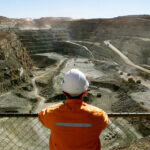Energy News Beat
What if some phenomenally large energy/materials breakthroughs were right here in front of us, vastly more accessible than experimental aspirations, but held back by an image problem?
To help ponder that question, it is necessary to share with you one of the best (meaning funniest), most explosive miscalculations in modern science; the reason for bringing it up is that it’s simply too good not to. But before that, some context.
It seems there are a number of energy paths ahead of us. One, there will be some sort of breakthrough in energy technology that ushers in a whole new way of powering things. But we can’t bank on that, for the same reason people can’t bank on lottery tickets for retirement. We don’t know if the breakthrough will actually happen, and even if one does, we don’t know what it would take to build it out – materials-wise, cost-wise, planning-wise, etc. (Please don’t send me a picture of what some team has working in the lab. Been far too dazzled by those things for decades now, call me when it’s on the market.)
We might get more comfortable societally with nuclear energy; the world seems hellbent on ‘carbon free energy’ and the only way that’s going to happen in a way that meets the needs of 8 billion people is nuclear power. But I get that some people get pretty rattled by nuclear energy, figuratively speaking, which I understand; nuclear fallout is probably not what you want to wake up and see dusting the patio furniture.
Far be it from me to add any negativity to the discussion however; I think nuclear is key to a low-emission future. Which brings me to the story mentioned at the outset.
By the 1950s, researchers had found that nuclear bombs were proficient at leveling cities, but there was much that was not known about them. To help answer questions, the US government launched the ominously goofily named Operation Plumbbob, a series of nuclear tests.
In 1956, a researcher named Dr. Robert Brownlee of the prestigious (before the experiment) Los Alamos National Laboratory in New Mexico was asked to examine whether nuclear explosions could be tested underground, and what would happen to the subterranean earth in such an event. He apparently said sure, why not, or some such.
To find out just what would happen, the researchers dutifully detonated a nuclear bomb named Pascal A 500 feet underground (the military had an odd habit of naming nuclear bombs; why they would want to humanize these things in any way whatsoever I have no clue). In the spirit of modern YouTubers, that attempt was a 1950s equivalent of hillbillies launching a claptrap Jeep across a creek and coming up 50 percent short. In other words, the Los Alamos scientists severely miscalculated. But the miscalculation was not due to insufficient energy, quite the opposite; the force of the blast was some 50,000 times higher than expected. As Dr. Brownlee, apparently a droll master of understatement, put it, “We figured you could keep everything in but for a few per cent by going underground. But Mother Nature can outwit you in a great variety of ways.” Dr. Brownlee described the resulting monstrous jet of fire as “the world’s finest Roman candle.”
They weren’t done there, however. With curious minds still wanting to know, the team stuffed Pascal B down a similar hole to detonate it similarly, but with a “fix” – the team welded a four-inch-thick metal and concrete cap weighing 900 kilograms/2,000 pounds, over the bomb to contain the explosion.
You just know this is gonna be good, right?
Dr. Brownlee suspected the weld wouldn’t hold and that the lid would be blown off, so to document the shenanigans, the team installed a high-speed camera nearby that would capture the action at a thousand frames per second. If the main force of the explosion did go upwards instead of downwards as hoped, all would be documented.
Mother Nature outwitted them again though, in a way. The cement/steel lid did blow off, and the camera did catch it doing so, but only for a fraction of an instant, a single millisecond, in a single frame. In other words, the massive slab was going like a rocket. Actually, far, far faster than a rocket – the scientists calculated the cement slab’s speed at 66 kilometers per second, or 150,000 miles per hour – six times the velocity required to escape earth’s orbit. “I have no idea what happened to that cap,” said Dr. Brownlee. There is a chance that the speed was such that it blasted into space and is sailing off to parts unknown as we speak (recent calculations suggest the lid simply vaporized, which is a pretty neat trick in its own right).
It is unfortunate for us humans with dark senses of humour that Dr. Brownlee’s team was never commissioned to design a ride at Disneyland.
Now, it stands to reason that significant technological developments won’t always have such colourful episodes, unfortunately, but that doesn’t mean they will go smoothly. We may grumble about our supply chains and the emissions thereof and the dominant reliance on hydrocarbons to make it all work, but look at the challenges of trying to ram any new energy system through rapidly. The existing system has been cobbled together over more than a century; people, cities, civilizations and our modern way of life have been wrapped around it. They exist because of it. Changing the fundamental system is not going to happen quickly, no matter what comes along as a new energy source.
If nuclear took off (no pun intended), it would be massively disruptive in its own way, as mining giant Robert Friedland recently pointed out in an interview (“If you have a nuclear reactor you can make hydrogen…Obviously if we were serious about this we’d immediately build two thousand or four thousand or five thousand one-thousand megawatt nuclear reactors. Now, how much metal do we need to weld those containment vessels? The United States has lost the capability to even build a nuclear plant… and so yeah we could build two, five thousand reactors, out of what? How much niobium in that containment vessel, how much vanadium in that specialty steel, how do you weld it, how much steel, concrete, rebar, how much raw materials do you need, how you going to organize it, how you going to mine it… how many nuclear engineers do you have to train to build that shit and to regulate it… do you think that’s actually going to happen?… You say definitely I say maybe… talk is cheap.”
People get excited about nuclear fusion and lithium metal batteries and heaven knows what dreams are going on in green brains, but any of them are going to be massively disruptive and a challenge to integrate, because it is hard to build any infrastructure anywhere, and our countless systems work because of that existing infrastructure. An energy transition is not like a transition from land lines to cell phones; it is more like moving every highway in the world a hundred meters to the east. Some fraction of that task would be easy, but much would be challenging beyond belief.
The world will be much, much better served if we leverage what we have and what we know to the full extent, without demonization, without vilification, in the full, purely scientific sense of curiosity.
Here then is a look at something we all should be excited about, particularly in Canada. The oil sands have been extensively vilified, and children around the world have been taught to loathe this inanimate natural oil deposit (a task made easier by giving a more repulsive name, tar sands – hey, in modern energy warfare, no strategy is too small).
It turns out that the bitumen – the heavy, thick oil component in the oil sands – has many potential uses beyond just burning it. Through decades of producing, processing, and refining it, we know a great deal about the goo. Combining the knowledge of bitumen itself with a view to other uses shows that there is staggering potential in the use of bitumen beyond combustion.
Logically enough then, there is a program called Bitumen Beyond Combustion (BBC), details of which can be found at the Alberta Innovates website. A fascinating white paper located there describes the program in detail. The concept is to divert produced bitumen from its use as a fuel towards using it to generate industrial products. Bitumen can generate a number of high value products including asphalt binder, carbon fibre, and numerous others.
Carbon fibre is my personal favourite, having been a Formula 1 fan for years. In a modern F1 car, as many components as possible are made from carbon fibre, including the basic chassis known as a monocoque, a weird name for what is sort of a tight bathtub that forms a shell around the driver and attaches to the engine. F1 designers call this carbon fibre structure “virtually indestructible”; doubters can check this picture of the wreckage of F1 driver Roman Grosjean’s car; the driver hit a track wall at close to 120 mph, and the carbon fibre tub and halo remained intact. The material is twice as strong as steel and five times lighter. An F1 car’s tub is usually made from 12 layers of carbon fibre mats. The whole thing weighs 35 kilograms, as much as a small goat but offering vastly better protection.
What makes these car parts interesting to all of you guys out there is that these fancy bath tubs cost an estimated US$700,000. It’s great stuff, but hideously expensive, which, for bitumen producers, spells opportunity. The BBC document shows a chart of value added to bitumen; as a combustible fuel the product is worth about $0.30-0.50/kilogram. As carbon fibre, the bitumen is worth $10-20/kilogram, and utilizes only about 20 percent of the barrel.
Those are staggering values to extract from a barrel of bitumen. As a whole, the BBC white paper estimates the following benefits. If one million barrels per day of bitumen is sold to refineries at $50/barrel after diluent removal, the revenue is $18 billion per year. If the same volume was used to create BBC products, the potential revenue is calculated at $42 billion. This number includes the value of BBC products ($28 billion) plus the value of the light ends remaining from the bitumen ($14 billion).
Of interest to the feds, and everyone with their Net Zero 20xx scorecard out, there are enormous emissions savings to be had here as well. For every million barrels of bitumen used for BBC, 480,000 barrels would be diverted to non-combustion BBC products. If used as a fuel that volume would generate 70 million tonnes of emissions per year. Furthermore, a study cited in the white paper estimates that carbon fibre derived from BBC would have a 52 percent lower life cycle GHG emissions intensity than conventionally produced carbon fibre.
Alberta Innovates estimates that total annual revenue from BBC could exceed $100 billion, yes that’s per year, by 2050.
Such great stuff! Imagine if this industry took off here in Alberta, and large quantities of oil sands output went into BBC manufacturing. This program should be a top priority if you ask me.
Oddly enough, it doesn’t seem to be. Certain groups like Alberta Innovates are working very hard on it and committing material sums. But the numbers devoted to BBC seem, relative to government largesse on virtually anything remotely considered ‘renewable’, kind of pathetic. Alberta Innovates notes some $20 million devoted to the program to date (feel free to correct if wrong, I may be missing some sums but not a lot). The federal government seems keen on the idea, having its own web page dedicated to bitumen beyond combustion, and it links to a bona fide research centre in Devon, Alberta, but that research centre’s website shows that most of the researchers are working on something else. All valid projects, it appears, and well worthwhile, but a focus on BBC there does not seem to be.
And that is ridiculous, in the context of the tens of billions being thrown around like confetti in the ‘energy transition’. The Alberta Innovates white paper outlines that it will take $300 million in total government investment over the next 10 years to recognize the full potential of BBC. Recall the prize: global-scale reductions in GHG emissions from utilizing bitumen rather than combustion, potential for $100 billion/year BBC revenues, backed by a 165-billion-barrel bitumen resource.
$300 million over 10 years. $30 million per year. The federal government recently contributed $150 million to the daffy plan to generate hydrogen in Newfoundland and ship it to Germany, and that amount is surely a tiny, tiny fraction of federal largesse that will be sent to the Rock for this plan that no one anywhere thinks makes sense. A CBC article noted how one of the participating companies is investing $160,000 in scholarships (wonder where that money came from) for students in new programs build on this hydrogen-to-Germany scheme (“While none of these wind hydrogen programs have gotten the provincial government’s green light, the College of the North Atlantic has launched two new programs to feed the industry”), though the article includes some appropriate head-scratching: “There are questions about where these students will go once they graduate – because there won’t be any wind hydrogen programs up and running in the province yet.”
If we as a country can somehow accomplish that, what can/should we do about as huge a prize as BBC, a prize of immense benefit using a lot of existing infrastructure, at relatively low cost, to generate an incredibly valuable product? For $30 million per year? That can’t be much more than the travel budget of a couple dozen of Ottawa’s elite planet savers. To be less facetious, a CBC story pegs Ontario’s planned Stellantis battery plant as receiving $15 billion in subsidies; the entire program cost for BBC is two percent of that total.
Politicians, energy transitionists, Alberta business leaders: I suggest it is imperative you put your shoulder behind BBC, and you should all be kicking in a lot more than $300 million over ten years. Other countries will get there faster if you don’t.
We don’t need crazy new ideas that blow huge manhole covers into outer space, figuratively speaking, but which blow similar sized holes in governmental budgets. We just need to use what we have right in front of us.
Energy conversations should be positive and, most of all, grounded in reality. Life depends on it. Find out more in “The End of Fossil Fuel Insanity” at Amazon.ca, Indigo.ca, or Amazon.com. Thanks!
Notice, He signed Stu’s Copy
The post Bitumen beyond combustion: how to triple oil sands value, reduce emissions, and create an advanced material industry for 2% of a battery plant’s subsidies appeared first on Energy News Beat.








